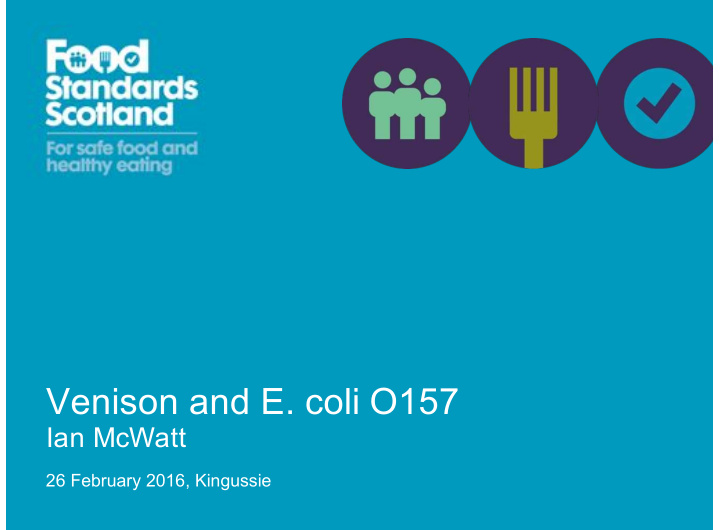



Venison and E. coli O157 Ian McWatt 26 February 2016, Kingussie
E. coli ! • 200-250 cases reported per year in Scotland • Most patients recover within 10 days • Symptoms bloody diarrhoea, abdominal cramps, fever and vomiting • 88 cases hospitalised (38%) • 10-15% of patients experience haemolytic uraemic syndrome (HUS) • In HUS cases 25% require long-term dialysis/kidney transplant • 1-2% fatality rate
E. coli ! • Incubation period of about 3–8 days • Infective dose is very low • E. coli can grow in temperatures ranging from 7°C to 50°C, with an optimum temperature of 37°C • E. coli can grow in acidic foods ! !
Pathogenic E. coli ! • Many types of E. coli commonly found in the guts of humans, ruminants etc. • Most are not pathogenic – although some types cause severe illness • E. coli O157 is most common pathogenic strain • Human infection also caused by non-O157 types • VTEC (Vero cytotoxin-producing Escherichia coli) = STEC (Shiga toxin- producing Escherichia coli) !
E. coli O157 cases ! ! !
Who is at risk?
E. coli infection transmission Indirect Direct transmission transmission Food Environmental exposure e.g. direct contact with farm animals or faeces Water Person to person
Where E. coli comes from
E. coli O157 and Meat Outbreaks • Wishaw, Scotland (1996) – 279 confirmed cases, 17 died • South Wales (2005) - 118 confirmed cases, 1 died
VTEC Action Plan • Set up by SG in 2010 following an audit of progress since the Task Force on E. coli O157 in 2001 • Representation from HPS, FSAS, NFUS, HUSH, HSE, LAs, NHS, RHET, DWQD, SRUC • An Action Plan was published Nov 2013 identifying priorities and recommendations to stakeholder groups: - risk reduction strategies - surveillance, research and education initiatives • FSS have responsibilities within the action plan • Progress will be monitored on an annual basis ! !
Venison - known source of E.coli Red Meat Many pathogens • E. Coli O157 Ruminant sources • Salmonella • Campylobacter • Mycobacterium avium • Mycobacterium Venison bovis Prevalence The Evidence • 0-10% • US Outbreaks • EU detected • (Cattle 20%) • Scotland
So what now? • FSS recognises venison as an important commodity both from a commercial and healthy eating perspective • Key benefits also include; sustainability and local production • But need to ensure food safety is integral part of maintaining reputation of industry • FSS keen to work with industry to improve awareness understanding of risks !
So what now? • Need to visit review commissioned by FSA in 2012 • Key recommendations provide a starting point … .. ! Education for all hunters supplying collecting agents and processors. That all wild game operators and collecting agents are ! registered with LA (FSS has a role to play with LAs) ! Need for greater intelligence / data on throughput (need also to define what small scale supply is, associated controls and any exemptions) ! Need to improve consistency in practice (collecting agents / hunters and maintenance of cold chain) ! Improved traceability – compulsory carcase tagging / review hunters declaration? ! !
So what now? Working(with(HPS((Dominic(Mellor)(and(the industry,(do(we(need(review(guidance(and eliminate(areas(of(confusion? ( What%is%certain%is%that%current working%practices%must%change%to protect%consumers%and%the%future of%the%industry
Recommend
More recommend